| 1 |
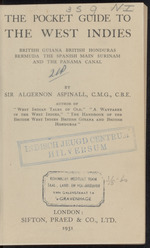 |
“...3 /Ki
THE POCKET GUIDE TO
THE WEST INDIES
BRITISH GUIANA BRITISH HONDURAS
BERMUDA THE SPANISH MAIN SURINAM
AND THE PANAMA CANAL
SIR ALGERNON ASPINALL, C.M.G., C.B.E.
AUTHOR OF
“ West Indian Tales of Old," " A Wayfarer
in the West Indies," " The Handbook of the
British West Indies British Guiana and British
Honduras”
BY
I KONINOX INSTITUUT Y00*
! TAAL-, LAND- £N VOl,\£NKUcJB£
van galenstraat 14
L ' 'i-GRAVCNHAGE
LONDON:
SIFTON, PRA'ED & CO., LTD
1931...”
|
|
| 2 |
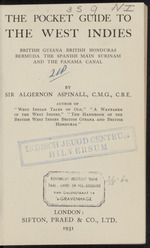 |
“...3 9 /Vjz:
THE POCKET GÜIDE TO
THE WEST INDIES
BRITISH GUIANA BRITISH HONDURAS
BERMUDA THE SPANISH MAIN SURINAM
AND THE PANAMA CANAL
BY
SIR ALGERNON ASPINALL, C.M.G., C.B.E.
AUTHOR OF
“ West Indian Tales of Old," " A Wayfarer
in the West Indies,” " The Handbook of the
British West Indies British Guiana and British
Honduras”
[j KONINKLIJK INSTITUUT VOOR L
! TAAL-, LAND- EN VOLKENKUNDE :
i i
| van Galenstraat 14 |
t 't-GRAVÊNHAGE
--------r
LONDON:
SIFTON, PRAED & CO., LTD.
I931...”
|
|
| 3 |
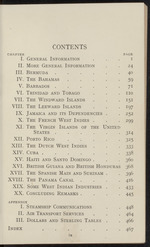 |
“...CONTENTS
CHAPTER PAGE
I. General Information . ... i
II. More General Information . . 24
III. Bermuda ...... 40
IV. The Bahamas . . . . .59
V. Barbados ...... 71
VI. Trinidad and Tobago . . .110
VII. The Windward Islands . . . 151
VIII. The Leeward Islands . . . 197
IX. Jamaica and its Dependencies . . 252
X. The French West Indies . . . ,299
XI. The Virgin Islands of the United
States ...... 314
XII. Porto Rico ..... 325
XIII. The Dutch West Indies . . . 333
XIV. Cuba ....... 338
XV. Haiti and Santo Domingo . . . 360
XVI. British Guiana and British Honduras 368
XVII. The Spanish Main and Surinam . . 396
XVIII. The Panama Canal .... 416
XIX. Some West Indian Industries . . 433
XX. Concluding Remarks .... 445
APPENDIX
I. Steamship Communications . . 448
II. Air Transport Services . . . 464
III. Dollars and Sterling Tables . . 466
Index . ... . . . 467
ix...”
|
|
| 4 |
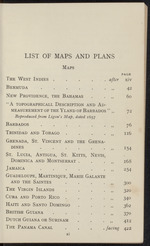 |
“...LIST OF MAPS AND PLANS
Maps The West Indies . . . . after PAGE xiv
Bermuda . . . . • , .* 42
New Providence, the Bahamas * • it 60
"A TOPOGRAPHICALL DESCRIPTION AND AD- MEASUREMENT OF THE YLAND OF BARBADOS ” „ 72
Reproduced from Ligon’s Map, dated 1657 Barbados ....... 76
Trinidad and Tobago . • • , 116
Grenada, St. Vincent and the dines . Grena- 154
St. Lucia, Antigua, St. Kitts, Nevis,
Dominica and Montserrat . 168
Jamaica .... 254
Guadeloupe, Martinique, Marie Galante AND THE SAINTES . . . . 300
The Virgin Islands 320
Cuba and Porto Rico . 340
Haiti and Santo Domingo 362
British Guiana 370
Dutch Guiana or Surinam 412
The Panama Canal . . facing 422
xi...”
|
|
| 5 |
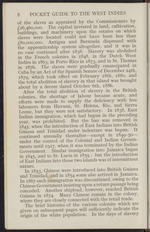 |
“...8 POCKET GUIDE TO THE WEST INDIES
of the slaves as appraised by the Commissioners by
£26,460,000. The capital invested in land, cultivation,
buildings, and machinery upon the estates on which
slaves were located could not have been less than
£80,000,000. Antigua and Bermuda dispensed with
the apprenticeship system altogether, and it was in
no case continued after 1838. Slavery was abolished
in the French colonies in 1848, in the Dutch West
Indies in 1863, in Porto Rico in 1873, and in St. Thomas
in 1876. The slaves were gradually emancipated in
Cuba by an Act of the Spanish Senate of December 24th,
1879, which took effect on February 18th, 1880, and
the total abolition of slavery in that island was brought
about by a decree dated October 6th, 1886.
After the total abolition of slavery in the British
colonies, the shortage of labour became acute, and
efforts were made to supply the deficiency with free
labourers from Havana, St. Helena, Rio, and Sierra
Leone, but they were not satisfactory...”
|
|
| 6 |
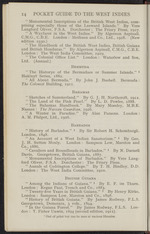 |
“...Islands." By Vere
Langford Oliver, F.S.A. Dorchester : The Friary Press, 1927.
“ A Wayfarer in the West Indies." By Algernon AspinaU,
C.M.G., C.B.E. London : Methuen and Co., Ltd., 1928. (New
edition 1930.)
" The Handbook of the British West Indies, British Guiana
and British Honduras.” By Algernon AspinaU, C.M.G., C.B.E.
London : The West India Committee, 1929.
" The Colonial Office List.” London : Waterlow and Son,
Ltd. (Annual.)
Bermuda
“ The Historye of the Bermudaes or Summer Islands.” 1
Hakluyt Series, 1882.
” All About Bermuda.” By John J. Bushel!. Bermuda:
The Colonist Building, ign.
Bahamas
“ Sketches of Summerland.” By G. J. H. Northcroft, 1912.
“ The Land of the Pink Pearl." By L. D. Powles, 1888.
" The Bahamas Handbook.” By Mary Moseley, M.B.E.
Nassau : The Nassau Guardian, 1926.
" A Winter in Paradise.” By Alan Parsons. London:
A. M. Philpot, Ltd., 1926.
Barbados
" History of Barbados.” 1 By Sir Robert H. Schomburgk.
London, 1848.
“ An Account of a West Indian Sanatorium.” 1 By...”
|
|
| 7 |
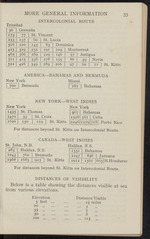 |
“...MORE GENERAL INFORMATION
INTERCOLONIAL ROUTE
35
Trinidad
96 Grenada ucia
173 77 St. Vincent
233 137 60 | St. L
316 220 143 1 83 Dominica
425 329 252 j 191 109 Montserrat
462 366 289 | 229 146 37 | Antigua
5ti 415 338 I 278 195 86 | 49 | Nevis
522 426 349 | 289 206 97 1 60 | 11 | St. Kitts
AMERICA—BAHAMAS AND BERMUDA
New York Miami
| 7°° I Bermuda j 187 | Bahamas
NEW YORK—WEST INDIES
New York
M35 St. Thomas
1470 35 | St. Croix
1620 150 | 119 | St. Kitts
New York
I 967 I Bahamas
I1528I 561 Cuba
I2246I1279 718I Porto Rico
For distances beyond St. Kitts see Intercolonial Route.
CANADA—WEST INDIES
St. John, N.B. Halifax, N.S.
283 Halifax, N.S. 1 1351 Bahamas
1043 760 Bermuda 1 2247 896 | Jamaica
1968 | 1685 925 I St. Kitts | 2912 1561 |665|B.Honduras
For distances beyond St. Kitts see Intercolonial Route.
DISTANCES OF VISIBILITY
Below is a table showing the distances visible at sea
from various elevations.
Elevation Distance Visible
5 feet ... ... 2| miles
20 ,, v; ... ••• 5
35 „ •••...”
|
|
| 8 |
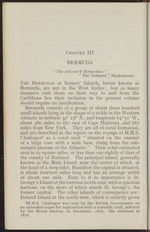 |
“...Chapter III
BERMUDA
“ The still vex’d Bermoothes "
" The Tempest,” Shakespeare.
The Bermudas or Somers’ Islands, better known as
Bermuda, are not in the West Indies; but as many
steamers visit them on their way to and from the
Caribbean Sea their inclusion in the present volume
should require no justification.
Bermuda consists of a group of about three hundred
small islands lying in the shape of a sickle in the Western
Atlantic in latitude 320 155' N., and longitude 64° 51' W.,
about 580 miles to the east of Cape Hatteras, and 667
miles from New York. They are all of coral formation,
and are described in the report on the voyage óf H.M.S.
Challenger1 as a coral atoll “ situated on the summit
of a large cone with a wide base, rising from the sub-
merged plateau of the Atlantic.” Their total estimated
area is 19 square miles, or less than one-eighth of that of
the county of Rutland. The principal island, generally
known as the Main Island, near the centre of which, at
the head of a deep inlet...”
|
|
| 9 |
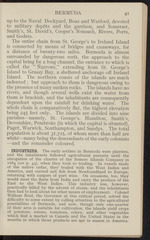 |
“...BERMUDA
4i
up to the Naval Dockyard, Boaz and Watford, devoted
to military depóts and the garrison, and Somerset,
Smith’s, St. David’s, Cooper’s Nonsuch, Rivers, Ports,
and Godets.
The entire chain from St. George’s to Ireland Island
is connected by means of bridges and causeways, for
a distance of twenty-two miles. Bermuda is almost
surrounded by dangerous reefs, the approach to the
capital being by a long channel, the entrance to which is
called the “ Narrows,” extending from St. George’s
Island to Grassy Bay, a sheltered anchorage off Ireland
Island. The northern coasts of the islands are much
indented ; but approach to them is dangerous owing to
the presence of many sunken rocks. The islands have no
rivers, and though several wells exist the water from
them is brackish, and the inhabitants are consequently
dependent upon the rainfall for drinking water. The
whole chain is comparatively flat, the highest elevation
being 245 feet only. The islands are divided into nine
parishes—namely...”
|
|
| 10 |
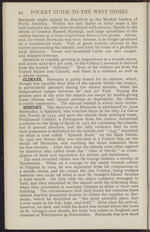 |
“...42 POCKET GUIDE TO THE WEST INDIES
Bermuda might indeed be described as the Market Garden of
North America. Within the last thirty or forty years a lily
bulb industry has also been developed with success, thanks to the
efforts of General Russell Hastings, and large quantities of the
variety known as Liliutn longiflorum Harrisii are grown. Arrow-
root, for which Bermuda was once famous, is no longer produced
on a commercial scale. Fish .of great variety abound in the
waters surrounding the islands, and form the basis of a profitable
local industry. Green and hawksbill turtle are also caught,
and shipped overseas.
Bermuda is steadily growing in importance as a tourist resort,
and about sixty-five per cent, of the Colony’s revenue is derived
from the tourist " industry.” Most of the visitors are from the
United States and Canada, and there is a summer as well as
a winter season.
CLIMATE. Bermuda is justly famed for its climate, which,
though less equable than that of the islands within the...”
|
|
| 11 |
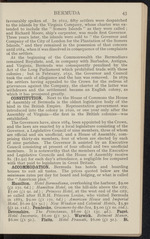 |
“...BERMUDA
43
favourably spoken of. In 1612, fifty settlers were despatched
to the islands by the Virginia Company, whose charter was ex-
tended to include the " Somers Islands ” as they were called ;
and Richard Moore, ship’s carpenter, was made first Governor.
Three years later, the islands were sold to “ the Governor and
Company of the City of London for the Plantation of the Somers
Islands," and they remained in the possession of that concern
until 1684, when it was dissolved in consequence of the complaints
of the settlers.
At the beginning of the Commonwealth the Bermudians
remained Royalists, and, in company with Barbados, Antigua,
and Virginia, Bermuda was consequently penalised by the
Act of the Long Parliament which prohibited trade with those
colonies ; but in February, 1652, the Governor and Council
took the oath of allegiance and the ban was removed. In 1679
the settlers having appealed to the Crown for the redress of
grievances against the Company, the charter of the latter was...”
|
|
| 12 |
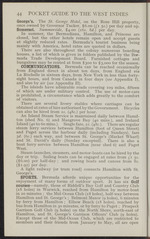 |
“...8d.) per day.
In summer, the Bermudiana, Hamilton, and Princess are
closed, but the other hotels remain open and accept guests
at slightly reduced rates. Bermuda’s tourist business being
mainly with America, hotel rates are quoted in dollars.
There are also throughout the colony numerous boarding
houses, a list of which is given in folders published by the Ber-
muda Trade Development Board. Furnished cottages and
bungalows may be rented at from $300 to $3,000 for the season.
COMMUNICATIONS. Bermuda can be reached occasionally
from England direct in about ten days, from England via
La Rochelle in sixteen days, from New York in less than forty-
eight hours, and from Canada in four days (see Appendix I),
and also by air (see Appendix II).
The islands have admirable roads covering 109 miles, fifteen
of which are under military control. The use of motor-cars
is prohibited, a circumstance which adds greatly to the comfort
of visitors.
There are several Every stables where carriages can be
obtained...”
|
|
| 13 |
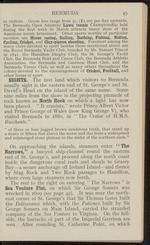 |
“...BERMUDA
45
to visitors. Green fees range from 5s. ($1.20) per day upwards.
The Bermuda Open Amateur Lawn tennis Championship held
during the first week in March attracts many stars of the
American tennis firmament. Other sports worthy of particular
mention are Horse racing, Sailing, Bathing, Fishing, Biding,
Cycling, Cricket, and Clay-pigeon shooting. Foremost among the
many clubs devoted to sport besides those mentioned above are
the Royal Bermuda Yacht Club, founded by Mr. Samuel Triscot
in 1841, the Hamilton Dinghy Club, the St. George’s Yacht
Club, the Bermuda Boat and Canóe Club, the Bermuda Athletic
Association, the Bermuda and Garrison Hunt Club, and the
Bermuda Tennis Club, as well as many others throughout the
colony devoted to the encouragement of Cricket, Football, and
other forms of sport.
SIGHTS. The first land which visitors to Bermuda
usually sight is the eastern end of St. George’s and St.
David’s Head on the island of the same name. Some
nine miles from the shore is the...”
|
|
| 14 |
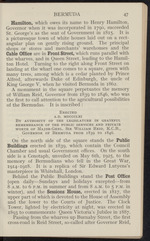 |
“...BERMUDA
47
Hamilton, which owes its name to Henry Hamilton,
Governor when it was incorporated in 1790, succeeded
St. George’s as the seat of Government in 1815. It is
a picturesque town of white houses laid out on a rect-
angular plan on gently rising ground. The principal
shops or stores and merchants’ warehouses and the
Cable Office are in Front Street, which runs parallel with
the wharves, and in Queen Street, leading to the Hamil-
ton Hotel. Turning to the right along Front Street on
landing at the wharf one comes to a square, green with
many trees, among which is a cedar planted by Prince
Alfred, afterwards Duke of Edinburgh, the uncle of
King George V, when he visited Bermuda in 1862.
A monument in the square perpetuates the memory
of William Reid, Governor from 1839 to 1846, who was
the first to call attention to the agricultural possibilities
of the Bermudas. It is inscribed :
Erected
A.D. MDCCCLXI
By authority of the legislature in grateful
REMEMBRANCE OF THE PUBLIC SERVICES AND...”
|
|
| 15 |
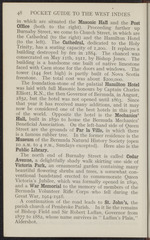 |
“... R.N., the then Governor of Bermuda, in August,
1852, but the hotel was not opened until 1863. Since
that year it has received many additions, and it may
now be considered one of the best hotels in this part
of the world. Opposite the hotel is the Mechanics’
Hall, built in 1850 to house the Bermuda Mechanics’
Beneficial Association. On the left-hand side of Queen
Street are the grounds of Par la Ville, in which there
is a famous rubber tree. In the former residence is the
Museum of the Bermuda Natural History Society (open
10 a.m. to 4 p.m., Sundays excepted). Here also is the
Public Library.
The north end of Burnaby Street is called Cedar
Avenue, a delightfully shady walk skirting one side of
Victoria Park, an ornamental garden containing many
beautiful flowering shrubs and trees, a somewhat con-
ventional bandstand erected to commemorate Queen
Victoria’s Jubilee, which was formally opened in 1890,
and a War Memorial to the memory of members of the
Bermuda Volunteer Rifle Corps who fell...”
|
|
| 16 |
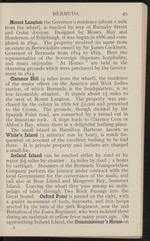 |
“...BERMUDA
49
Mount Langton the Governor’s residence (about i mile
from the wharf), is reached by way of Burnaby Street
and Cedar Avenue. Designed by Messrs. Hay and
Henderson, of Edinburgh, it was begun in 1886 and com-
pleted in 1892. The property received its name from
an estate in Berwickshire owned by Sir James Cockbum,
Governor of Bermuda from 1814 to 1819. Here the
representative of the Sovereign dispenses hospitality,
and many enjoyable “ At Homes ” are held in the
charming grounds which were purchased by the Govern-
ment in 1814.
Clarence Hill (4 miles from the wharf), the residence
of" the senior officer on the America and West Indies
station, of which Bermuda is the headquarters, is no
less favourably situated. It stands about ij miles to
the west of Mount Langton. The property was pur-
chased by the colony in 1816 for £2,000 and presented
to the Crown. The grounds, though divided by the
Spanish Point road, are connected by a tunnel cut in
the limestone rock. A slope leads to Clarence...”
|
|
| 17 |
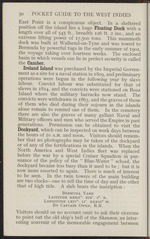 |
“...50 POCKET GUIDE TO THE WEST INDIES
East Point is a conspicuous object. In a sheltered
position off the island lies a huge Floating Dock with a
length over all of 545 ft., breadth 126 ft. 2 ins., and an
extreme lifting power of 17,500 tons. This mammoth
dock was built at Wallsend-on-Tyne and was towed to
Bermuda by powerful tugs in the early summer of 1902,
the voyage taking over fourteen weeks. The enclosed
basin in which vessels can lie in perfect security is called
the Camber.
Ireland Island was purchased by the Imperial Govern-
ment as a site for a naval station in 1809, an<3 preliminary
operations were begun in the following year by slave
labour. Convict labour was substituted for that of
slaves in 1824, and the convicts were stationed on Boaz
Island where the military barracks now stand. The
convicts were withdrawn in 1863, and the graves of those
of them who died during their sojourn in the islands
alone remain to remind one of them. In the cemetery
there are also the graves of many...”
|
|
| 18 |
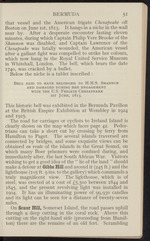 |
“...BERMUDA
5i
that vessel and the American frigate Chesapeake off
Boston on June 1st, 1813. It hangs in a niche in the wall
near by. After a desperate encounter lasting eleven
minutes, during which Captain Philip Vere Brooke of the
Shannon was disabled, and Captain Lawrence of the
Chesapeake was fatally wounded, the American vessel
after a gallant fight was compelled to strike her colours,
which now hang in the Royal United Service Museum
in Whitehall, London. The bell, which bears the date
1740, was cracked by a bullet.
Below the niche is a tablet inscribed :
Bell said to have belonged to H.M.S. Shannon
AND DAMAGED DURING HER ENGAGEMENT
with the U.S. Frigate Chesapeake
ist June, 1813.
This historic bell was exhibited in the Bermuda Pavilion
at the British Empire Exhibition at Wembley in 1924
and 1925.
The road for carriages or cyclists to Ireland Island is
clearly shown on the map which faces page 42. Pedes-
trians can take a short cut by crossing by ferry from
Hamilton to Paget. The several...”
|
|
| 19 |
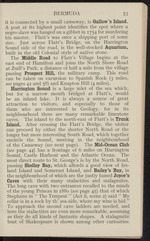 |
“...BERMUDA
53
it is connected by a small causeway, is Gallow’s Island.
A post at its highest point identifies the spot where a
negro slave was hanged on a gibbet in 1754 for murdering
his master. Flatt’s was once a shipping port of some
size. Just across Flatt’s Bridge, on the Harrington
Sound side of the road, is the well-stocked Aquarium,
built in the old Colonial style of native stone.
The Middle Road to Flatt’s Village begins at the
east end of Hamilton and joins the North Shore Road
at Zuill’s Park, a distance of half a mile from the village
passing Prospect Hill, the military camp. This road
can be taken on excursion to Spanish Rock (3 miles,
see pages 42 and 58) and Knapton Hill (4 miles).
Harrington Sound is a large inlet of the sea which,
but for a narrow mouth bridged at Flatt’s, would
be an inland lake. It is always a source of great
attraction to visitors, and especially to those of
them who are interested in Geology, for in its
neighbourhood there are many remarkable limestone...”
|
|
| 20 |
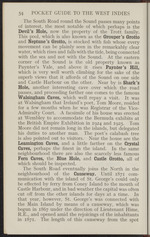 |
“...well worth climbing, for the sake of the
superb views that it affords of the Sound on one side
and Castle Harbour on the other. Near by is Shark’s
Hole, another interesting cave .over .which the road
passes, and proceeding farther one comes to the famous
Walsingham Caves, which well repay a visit. It was
at Walsingham that Ireland’s poet, Tom Moore, resided
for a few months when he was Registrar of the Vice-
Admiralty Court. A facsimile of his house was erected
at Wembley to accommodate the Bermuda exhibits at
the British Empire Exhibition in 1924 and 1925. Tom
Moore did not remain long in the islands, but delegated
his duties to another man. The poet’s calabash tree
is also pointed out to visitors. ■ Near the house are the
Leamington Caves, and a little farther on the Crystal
Caves, perhaps the finest in the island. In the same
neighbourhood there are also the scarcely less famous
Fern Caves, the Blue Hole, and Castle Grotto, all of
which should be inspected.
The South Road eventually...”
|
|
